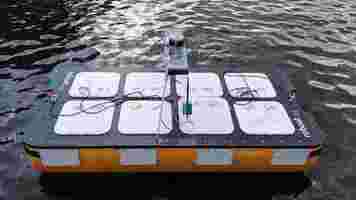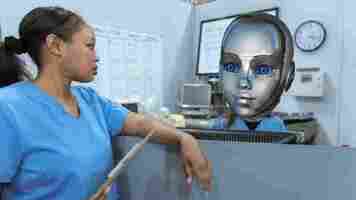MIT’s new autonomous boat ruled Amsterdam’s canals for 3 hours
When it comes to autonomous transportation, people primarily talk about cars, buses, and lorries. For cities like Amsterdam, its waterways are an important method of moving people and cargo around. So, it’s another territory autonomous vehicle researchers are exploring as a futurist way of transport.

Recently, researchers MIT‘s Computer Science and Artificial Intelligence Laboratory (CSAIL) successfully completed a trial of its autonomous half-sized (2-meters long) vessel, Roboat II. The ship completed a three-hour course of Amsterdam‘s canals and returned to the starting point with an error of just 0.17 meters.
MIT started the 5-year long transportation project along with the Amsterdam Institute for Advanced Metropolitan Solutions with the first public demo held in October 2018. Roboat II is the second version of the boat in the project with improved capacity for freight.
The vessel weighs 50kgs and it’s equipped with four propellers LiDAR, GPS, and other internal sensors that allows it to move in any direction. It has an adjustable design to carry both cargo and people (capacity of two person).
The Roboat II has an updated algorithm for Simultaneous Localization and Mapping (SLAM), so the controller can assign it tasks such as passenger pickup. Once the task is assigned, the algorithm automatically charts its path based on conditions such as weather and traffic.
Because of its modular nature, a “leader” boat can work with a fleet of other autonomous boats to carry a large set of cargo around the city. Researchers are using a technique called “distributed control system” to manage communication between leader and follower boats.
“The development of an autonomous boat system capable of accurate mapping, robust control, and human transport is a crucial step towards having the system implemented in the full-scale Roboat. We also hope it will eventually be implemented in other boats in order to make them autonomous,” says Wei Wang, a senior postdoctoral associate from the Senseable City Lab and CSAIL.
As a next step, researchers are aiming to build a bigger (4-meter) version of the boat that can carry 4-6 passengers. In addition to this, the team wants to improve real-time object detection and identification, so that it can tackle more complex scenarios that might occur in city waterways. Plus, it wants to create adaptive controls so that the internal structure of the boat change depending on the object placed on it.
Grace the robot nurse can’t replace human caregivers
The makers of Sophia the robot have unveiled another creepy-looking humanoid: Grace, a healthcare droid designed to help the elderly and isolated.

The prototype device uses AI to diagnose patients and a thermal camera to take their temperatures. It can also provide social stimulation and talk therapy, Reuters reports .
The robot could provide some support to overworked medical staff and people feeling lonely during the pandemic. But, at best, it will augment rather than replace human carers.
Social robots are already widely used in Japan — and some users clearly love them . Ultimately, they may become essential in an aging world with worker shortages, but critics fear they’ll be a cruel way to support the vulnerable.
They warn that robots are less emotionally satisfying than interaction with humans and that their long-term effects remain unknown. Some argue that the very concept of automated care is an oxymoron.
There are also concerns that social robots will reduce the user’s contact with human family, friends, and caregivers.
“One of the problems of aging is that it often results in a loss of social life and human contact,” said robotics experts Amanda Sharkey and Noel Sharkey in their paper Granny and the Robots .
“The worry is that the use of robots in elder care for tasks such as lifting, carrying, or even cleaning, might result in a reduction in the amount of human social contact that an elderly person experiences.”
Hanson Robotics, Grace’s maker, has given the droid the appearance of a woman with Asian features and a nurse’s uniform. Research suggests that anthropomorphizing robots can foster user trust and creates a more natural engagement. But it can also lead to overtrust and unrealistic perceptions of a robots’ capabilities.
Grace also needs to prove that it can live up to the hype. Hanson Robotics has frequently been accused of exaggerating the abilities of Sophia, which Facebook’s Chief AI Scientist once described as an “animatronic puppet.” If Grace is ever offered to my own vulnerable relatives, I’d want to know exactly how the strings are being pulled.
Greetings Humanoids! Did you know we have a newsletter all about AI? You can subscribe to it right here .
Harvard researchers developed an AI to determine how medical treatments affect life spans
A new AI system that predicts the health spans of mice could help develop life-extension interventions for humans, according to the tool’s inventors.

The system analyzes established measures of frailty to gauge a mouse’s chronological age and their so-called biological age — the condition of their physical and mental functions.
It was created by researchers from Harvard Medical School’s Sinclair Lab, who say it’s the first study to track a mouse’s frailty for the duration of its life.
They plan to use the predictions to quickly test interventions intended to extend the mice’s lives and move towards doing the same in humans.
“It can take up to three years to complete a longevity study in mice to see if a particular drug or diet slows the aging process,” said study co-first author Alice Kane, a research fellow in genetics at Harvard Medical School’s Sinclair Lab. “Predictive biometrics can accelerate such research by indicating whether an intervention is likely to work.”
The team first tracked the health of 60 aging mice until they died naturally. For more than a year, they carried out non-invasive tests on the mice, such as measures of their walking ability, back curvature, and hearing loss.
They used this training data to develop two AI models: one that detects a mouse’s biological age based on its frailty, and another that predicts how much longer it will live. In tests, the forecasts were accurate to within two months.
Testing interventions
The researchers then tracked the frailty of two groups of mice given life-extending treatment or diets. The team claims the AI accurately predicted whether the interventions improved their future health or life expectancy.
The system also found that certain measures of frailty had a stronger link to future health. For example, hearing loss and body tremors were more closely connected to biological age than vision and whisker loss. In the future, the researchers want to give these factors more weight in their calculations.
The team admits the AI can’t yet be used to predict human health, which is influenced by a far more complex range of factors than those that affect mice. Frailty indices already exist for people, but the researchers haven’t found a suitable dataset tracking people from their 60s to their 90s with significant mortality follow-up data.
Nonetheless, they hope to one day develop a system that can more quickly and accurately predict human health spans and the effectiveness of life-extending interventions.
“Diseases like cardiovascular disease, cancer, diabetes, neurodegeneration, and even severe COVID-19 predominantly affect older people,” said Kane. “We want to understand how the aging process itself works so we can find ways to reduce the incidence of all these diseases together, rather than one at a time.”
Researchers who wanna check how long their own mice have left to live can try the tools out for themselves. You can also read the research paper in Nature Communications .
So you’re interested in AI? Then join our online event, TNW2020 , where you’ll hear how artificial intelligence is transforming industries and businesses.